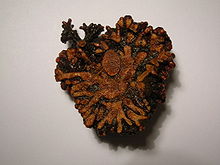Actinorhizal plant
Actinorhizal plants are a group of
Actinorhizal plants are distributed within three clades,[1] and are characterized by nitrogen fixation.[2] They are distributed globally, and are pioneer species in nitrogen-poor environments. Their symbiotic relationships with Frankia evolved independently over time,[3] and the symbiosis occurs in the root nodule infection site.[4]
Classification
Actinorhizal plants are
: Table S1| Classification | Order | Familiy | Genera | |
|---|---|---|---|---|
| The Clade Angiosperm
|
Actinorhizal Plants | Cucurbitales | Coriariaceae
|
Coriaria |
Datiscaceae
|
Datisca | |||
| Fagales | Betulaceae | Alnus | ||
| Casuarinaceae | Allocasuarina | |||
| Casuarina | ||||
| Ceuthostoma | ||||
| Gymnostoma | ||||
| Myricaceae | Comptonia | |||
| Myrica | ||||
| Rosales | Elaeagnaceae | Elaeagnus | ||
| Hippophae | ||||
| Shepherdia | ||||
| Rhamnaceae | Adolphia | |||
| Colletia | ||||
| Discaria | ||||
| Kentrothamnus | ||||
| Retanilla | ||||
Talguenea
| ||||
| Trevoa | ||||
| Ochetophila | ||||
| Ceanothus | ||||
| Rosaceae | Cercocarpus | |||
| Chamaebatia | ||||
Cowania
| ||||
| Dryas | ||||
| Purshia | ||||
| Legumes | Fabales | Fabaceae | Caesalpinia | |
| Cercis | ||||
| Detarium | ||||
| Dialium | ||||
| Duparquetia | ||||
| Faboideae | ||||
| Polygalaceae | Polygala | |||
| Quillajaceae | Dakotanthus | |||
| Quillaja | ||||
| Surianaceae | Suriana |

All nitrogen fixing plants are classified under the "Nitrogen-Fixing Clade",
Distribution and ecology

Actinorhizal plants are found on all continents except for Antarctica. Their ability to form nitrogen-fixing nodules confers a selective advantage in poor soils, and are therefore pioneer species where available nitrogen is scarce, such as moraines, volcanic flows or sand dunes.[11] Being among the first species to colonize these disturbed environments, actinorhizal shrubs and trees play a critical role, enriching the soil[12] and enabling the establishment of other species in an ecological succession.[5][11] Actinorhizal plants like alders are also common in the riparian forest.[11] They are also major contributors to nitrogen fixation in broad areas of the world, and are particularly important in
Evolutionary origin

No fossil records are available concerning nodules, but fossil pollen of plants similar to modern actinorhizal species has been found in sediments deposited 87 million years ago. The origin of the symbiotic association remains uncertain. The ability to associate with Frankia is a
The symbiotic nodules
As in legumes,
Notes
- ^ a b "Angiosperm Phylogeny Website". www.mobot.org. Retrieved 2024-03-07.
- ^ PMID 26354898.
- ^ a b Benson & Clawson 2000
- ^ ISBN 978-0-12-409548-9, retrieved 2024-03-08
- ^ a b c Wall 2000
- ^ PMID 33263880, retrieved 2024-03-15
- ISBN 978-0-323-91875-6. Retrieved March 15, 2023.
- PMID 36562043.
- PMID 24350296.
- PMID 17151343.
- ^ a b c Schwintzer & Tjepkema 1990
- ^ Restoration, Society for Ecological. "Society for Ecological Restoration (SER)". Society for Ecological Restoration. Retrieved 2024-03-15.
- ^ Zavitovski & Newton 1968
- ^ Kistner & Parniske 2002
- ^ PMID 23333963.
- ^ S2CID 254082345.
- PMID 16441749.
- PMID 18316735.
- PMID 31588247.
References
- Wall, L. (2000), "The actinorhizal symbiosis", Journal of Plant Growth and Regulation, 19 (2): 167–182, S2CID 12887261
- Schwintzer, C. R.; Tjepkema, J. (1990), The Biology of Frankia and Actinorhizal Plants, Academic Press, ISBN 978-0-12-633210-0
- Benson, D. R.; Clawson, M. L. (2000), "Evolution of the actinorhizal plant nitrogen-fixing symbiosis", in Triplett, E. (ed.), Prokaryotic Nitrogen Fixation: A Model System for the Analysis of a Biological Process, Norfolk, UK: Horizon Scientific Press, pp. 207–224, ISBN 978-1-898486-19-0
- Zavitovski, J.; Newton, M. (1968), "Ecological importance of snowbrush Ceanothus velutinus in the Oregon cascade", Ecology, 49 (6): 1134–1145, JSTOR 1934497
- Kistner, C.; PMID 12417152
- Laplaze, L.; Duhoux, E.; Franche, C.; Frutz, T.; Svistoonoff, S.; PMID 10656591
- Vessey, J. K.; Pawlowski, K.; Bergman, B. (2005), "Root-based N2-fixing symbioses: Legumes, actinorhizal plants, Parasponia sp. and cycads", Plant and Soil, 266 (1): 205–230, S2CID 35247396
- Gherbi, H.; Markmann, K.; Svistoonoff, S.; Estevan, J.; Autran, D.; Giczey, G.; Auguy, F.; Péret, B.; Laplaze, L.; Franche, C.; Parniske, M.; Bogusz, D. (2008), "SymRK defines a common genetic basis for plant root endosymbioses with arbuscular mycorrhiza fungi, rhizobia, and Frankia bacteria", Proceedings of the National Academy of Sciences, 105 (12): 4928–4932, PMID 18316735
- Hocher, V.; Auguy, F.; Argout, X.; Laplaze, L.; Franche, C.; Bogusz, D. (2006), "Expressed sequence-tag analysis in Casuarina glauca actinorhizal nodule and root", New Phytologist, 169 (4): 681–688, PMID 16441749
- Normand, P.; Lapierre, P.; Tisa, L. S.; Gogarten, J. P.; Alloisio, N.; Bagnarol, E.; Bassi, C. A.; Berry, A. M.; Bickhart, D. M.; Choisne, N.; Couloux, A.; Cournoyer, B.; Cruveiller, S.; Daubin, V.; Demange, N.; Francino, M. P.; Goltsman, E.; Huang, Y.; Kopp, O. R.; Labarre, L.; Lapidus, A.; Lavire, C.; Marechal, J.; Martinez, M.; Mastronunzio, J. E.; Mullin, B. C.; Niemann, J.; Pujic, P.; Rawnsley, T.; Rouy, Z. (2006). "Genome characteristics of facultatively symbiotic Frankia sp. Strains reflect host range and host plant biogeography". Genome Research. 17 (1): 7–15. PMID 17151343.
